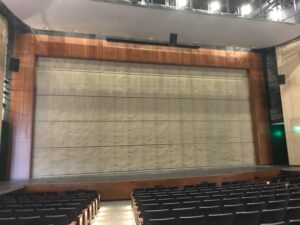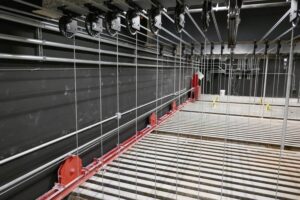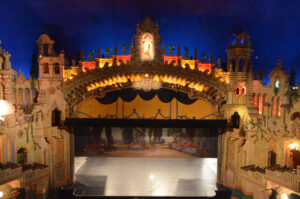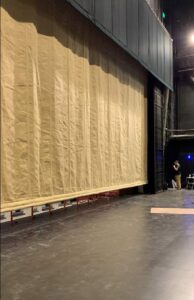Origins of the 50-ft Stage Rule for Fire Safety Curtains
A common question to theatre consultants is about the origin and basis of the” fifty foot rule” for requiring proscenium opening protection between the stage and auditorium. For background, the first fire safety curtain is reported to have been installed at the third Theatre Royal, Drury Lane, in 1794 for property protection. As live theatre became a popular form of entertainment, more theatres were constructed and there were more fires and loss of life. Modern Opera Houses and Theatres published in 3 volumes, by Edwin O. Sachs and Ernest A. E. Woodrow, published 1896 through 1898, documents that the average life of a theatre built between 1850 and 1900 was five years before there was a substantial loss from fire. The 1887 fire at the Royal Theatre, Exeter, claimed 200 lives, and resulted in the first known requirement for fire safety curtains in the UK.
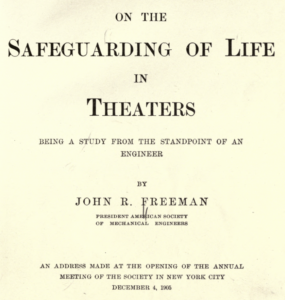
On the Safeguarding of Life in Theaters (1906) is an engineering study of fires in theatres, with extensive discussion of the 1903 Iroquois Theater fire and recommendations for improvement. (Click on image to download.)
The Iroquois Theatre (Chicago) fire of 1903 resulted in requirements for fire safety curtains on all “full working stages” in the US. In the following eighty-plus years, until The American Society of Theatre Consultants (ASTC) became an active participant in US code development, the “full working stage’ criteria evolved to any stage with “retractable scenery”, which was sometimes interpreted to include a performer carrying a banner on stage.
At the time of the Iroquois Theatre fire, theatres were operated predominantly for profit, in contrast to today when all but Broadway and similar theatres are not-for-profit and overwhelmingly by their numbers in education. Likewise, the amount of combustible material on stages has decreased dramatically. Read On the Safeguarding of Life in Theatres, a paper presented in 1906 by John R. Freeman to the American Society of Mechanical Engineers (ASME) reporting on the Iroquois Theatre fire and contrast his detailed survey of the combustibles on stage with what is found on today’s stages. From On the Safeguarding of Life in Theatres:
It would be shocking to see this quantity of combustible materials over a stage in the modern era. Finally, the open flame and exposed arc lighting found in Sachs and Woodrow’s day are long past, having been replaced by enclosed electric incandescent lighting and now being replaced by much less heat-intensive LED lighting. It’s no wonder theatres burned with shocking regularity. Economics, societal changes, cinema, television and the expectations of realism, projections, LED displays, technology, modern sprinkler systems, and the internet make the early 20th Century stage barely recognizable today.
The Board for the Coordination of Model Codes (BCMC) was formed by the Council of American Building Officials (CABO) in 1975, stayed active until about 1995, and included representatives from the model building codes, including BOCA, ICBO, SBCCI, and NFPA. The BCMC started a process of code revision and coordination because “the apparent conflicts and contradictions in the model codes were likely to be brought into close agreement if code drafters could view the same facts in the context of similar experiences”. In 1987, ASTC submitted a proposal to the BCMC to update the model code requirements for stages. The BCMC accepted ASTC’s proposal in the October 1987. After three meetings a year for five years, BCMC issued a report at the May 1992 meeting, available at the ASTC website. This 1992 BCMC report is the basis for current code sections on stages in the International Building Code (IBC), and the provisions were also incorporated into NFPA 101 Life Safety Code.
Deliberations included some acknowledgment that codes had not kept up with the changes in theatres and the activity in them since the early part of the 20th century, and some recognition that the “retractable scenery” criteria did not accurately reflect the fire hazard. Wanting to have some clear measurable criteria for when a fire safety curtain is required, and focusing on the use of “heights and areas” for so many other requirements in the codes, ASTC proposed a stage height of 45-feet, which practically limited the storage of multiple settings over a stage. The final BCMC report opted for 50-feet, paralleling the proven effectiveness of fire sprinklers up to that height. Here are two relevant excerpts from the BCMC report, starting with the official recommendation, then the commentary (in italics) below:
5.1.1 All portions of a stage area with a stage height greater than 50 feet shall be within an area separated from all other building areas by 2 hour fire-resistance rated construction with protected openings except that the main opening in the proscenium wall used for viewing performances shall be provided with proscenium opening protection. The 2 hour fire resistance rated construction shall extend to the roof or floor deck above the auditorium.5.4.3 The proscenium opening shall be protected by an approved fire curtain or an approved water curtain complying with NFiPA 13 (4-4.2.1). The fire curtain shall be designed to close automatically upon automatic detection of a fire and upon manual activation and shall resist the passage of flame and smoke for 20 minutes between the stage area and the audience area.
The concept of separating the stage (assumed to be the most likely area for a fire to originate) from the audience within a single occupancy was discussed at length. While some testimony dwelled on prevention of panic as a result of occupants seeing the effects of a fire, there was not documentation to support this. To the contrary, contemporary research on behavioral response to fire and smoke indicates this is not a problem. There is no evidence of non-adaptive behavior reducing the escape possibilities or causing injury.The fire curtain may function as a smoke barrier if it closes. Therefore, utilizing the deluge system in lieu of a fire curtain places more reliance on the smoke control or roof vents to maintain smoke protected means of egress for the egress time.
There were no records of civilian deaths or injuries resulting from a fire in a theatre in recent history presented. (This is roughly since the use of the electric light became commonplace early in this century.) There were several cases of major loss of property in theatres, all in Europe, and all in non-sprinklered stages as is common in Europe.
Testimony was presented indicating that a large proportion of fire curtains, somewhere between 50 and 95 percent, are not properly installed or are not properly maintained and are not fully operative. The Board encourages the entertainment industry to develop a performance standard with appropriate requirements for the design, installation, testing, inspection, and reliable operation of fire curtains.
Recognizing the absence of major stage fires in the thirty years since this report was issued and nearly one hundred and twenty years since the Iroquois Theatre fire, it also becomes clear a lot has changed. Fire sprinkler, fire detection, and smoke exhaust systems on stages are reliable and improving. Further reducing the risk are changes in lighting technology; continued reduction of combustible materials in scenery; and the increasing use of projections in place of multiple cloth backdrops. It may be time to again convene and review the codes and standards for stages.
By Bill Connor, FASTC
Disclaimer: Any views or opinions expressed in this article are solely those of the author and do not necessarily represent those of the American Society of Theatre Consultants. This article is for general information only and should not be substituted for specific advice from a Theatre Consultant, Code Consultant, or Design Professional, and may not be suitable for all situations nor in all locations.



